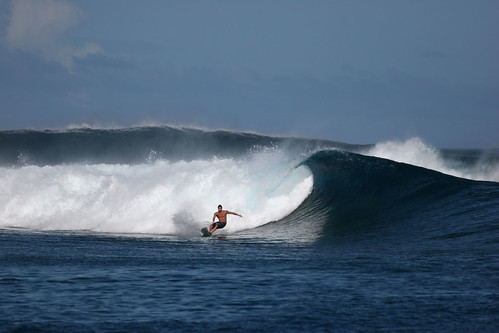 A study by Australia's Commonwealth Scientific and Industrial Research Organisation (CSIRO) has warned that the world's coastline beaches could experience swelling and intense levels and heights of pounding ocean waves due to climate change. Mark Hemer, CSIRO researcher and lead author of the study, said average annual wave heights could increase by as much as half a metre in coming decades as storm frequency and intensity in the Southern Ocean likewise increase.
A study by Australia's Commonwealth Scientific and Industrial Research Organisation (CSIRO) has warned that the world's coastline beaches could experience swelling and intense levels and heights of pounding ocean waves due to climate change. Mark Hemer, CSIRO researcher and lead author of the study, said average annual wave heights could increase by as much as half a metre in coming decades as storm frequency and intensity in the Southern Ocean likewise increase.
The heightened wave heights will occur seven per cent across the global ocean, predominantly in the Southern Ocean.
"But what people generally don't appreciate is changes in wave climate can cause changes to the coast as large, if not potentially larger, as sea level change can."
"Most people understand sea level as a risk in a coastal zone," Dr Hemer told AAP.
Noting 20 per cent of the world's coastlines are sandy beaches prone to natural or man-made changes, he said 10 per cent of these sandy coasts have been seen to be becoming wider as they build seawards, while 70 per cent were seen eroding. The rest remain stable.
"Waves are dominant drivers of coastal change in these sandy environments, and variability and change in the characteristics of surface ocean waves (sea and swell) can far exceed the influences of sea-level rise in such environments."
Essentially, seawater intrusions into low lying areas could be extended due to the higher waves. Moreover, bigger waves, including the changes in the angle at which waves struck, may likewise trigger faster beach erosion.
"If we wish to understand how our coasts might respond to future changes in climate then we need to try and understand how waves might respond to the projected changes in global atmospheric circulation seen as shifts in storm frequency, storm intensity and storm tracks," Dr Hemer said.
In Australia, specifically, while this may be good news to surfers frequenting Australia's Tasmanian coasts, the reverse could happen to the Gold Coast.
"For the Gold Coast the models suggest a slight decrease in the wave heights during summer, but maybe a slight increase during winter months associated with the strengthening of trade winds during that time," Mr Hemer said.
John Neilsen, Gold Coast Surf Industry Taskforce chairman, had actually seen changes coming.
"I don't think the waves are as good as they used to be -- they are already being affected," he was quoted by Gold Coast Bulletin.
"Surfers would rather surf than breathe and if the waves aren't here, they won't be either."
Source: International Business Times - Australia
Image courtesy of colmsurf via Flickr (CC BY 2.0)
